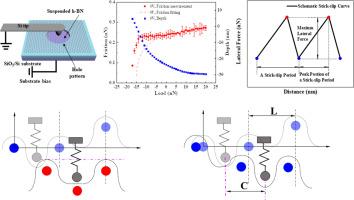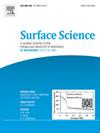Flexible contact and friction of suspended h-BN dominated by adhesion
IF 1.8
4区 化学
Q3 CHEMISTRY, PHYSICAL
引用次数: 0
Abstract
Hexagonal boron nitride (h-BN), known for its exceptional stability as a solid lubricant, holds great promise for applications in nano/micro electromechanical systems (N/MEMS). The friction-contact force curve of suspended h-BN exhibited an anomalous plateau near zero applied load, during which the friction coefficient reached its minimum. Upon applying an electric field, the friction coefficient at this plateau can become negative. As the applied load decreased to a level apporaching the magnitude of adhesion force, the influence of normal load on the contact geometry diminished, while the effect of adhesion became more pronounced, thereby slowing the rate of friction reduction. The transition from contact force to adhesive force as the dominant factor in maintaining contact area is referred to as flexible contact. By analyzing the periodic characteristics of the atomic-scale friction curves, the mechanism by which adhesion drives the transition from rigid to flexible contact—and its contribution to nanofriction is revealed. The ability to tune adhesion, particularly through electrostatic interaction, offers valuable insights into controlling frictional energy dissipation in N/MEMS system.

悬浮h-BN的柔性接触和摩擦以粘附为主
六方氮化硼(h-BN)以其作为固体润滑剂的优异稳定性而闻名,在纳米/微机电系统(N/MEMS)中应用前景广阔。悬浮h-BN的摩擦-接触力曲线在零外加载荷附近呈现异常平台,在此期间摩擦系数达到最小。施加电场后,在这个平台上的摩擦系数可以变为负值。当施加的载荷减小到接近附着力大小的水平时,法向载荷对接触几何形状的影响减弱,而附着力的影响变得更加明显,从而减缓了摩擦减少的速度。从接触力到粘附力作为维持接触面积的主要因素的过渡被称为柔性接触。通过分析原子尺度摩擦曲线的周期特征,揭示了黏附驱动刚性接触向柔性接触转变的机理及其对纳米摩擦的贡献。调节粘附的能力,特别是通过静电相互作用,为控制N/MEMS系统中的摩擦能量耗散提供了有价值的见解。
本文章由计算机程序翻译,如有差异,请以英文原文为准。
求助全文
约1分钟内获得全文
求助全文
来源期刊

Surface Science
化学-物理:凝聚态物理
CiteScore
3.30
自引率
5.30%
发文量
137
审稿时长
25 days
期刊介绍:
Surface Science is devoted to elucidating the fundamental aspects of chemistry and physics occurring at a wide range of surfaces and interfaces and to disseminating this knowledge fast. The journal welcomes a broad spectrum of topics, including but not limited to:
• model systems (e.g. in Ultra High Vacuum) under well-controlled reactive conditions
• nanoscale science and engineering, including manipulation of matter at the atomic/molecular scale and assembly phenomena
• reactivity of surfaces as related to various applied areas including heterogeneous catalysis, chemistry at electrified interfaces, and semiconductors functionalization
• phenomena at interfaces relevant to energy storage and conversion, and fuels production and utilization
• surface reactivity for environmental protection and pollution remediation
• interactions at surfaces of soft matter, including polymers and biomaterials.
Both experimental and theoretical work, including modeling, is within the scope of the journal. Work published in Surface Science reaches a wide readership, from chemistry and physics to biology and materials science and engineering, providing an excellent forum for cross-fertilization of ideas and broad dissemination of scientific discoveries.
 求助内容:
求助内容: 应助结果提醒方式:
应助结果提醒方式:


